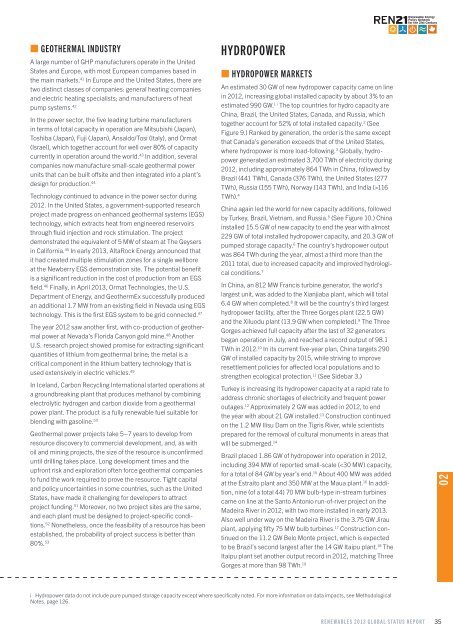RenewableS 2013 GlObal STaTUS RePORT - REN21
RenewableS 2013 GlObal STaTUS RePORT - REN21
RenewableS 2013 GlObal STaTUS RePORT - REN21
You also want an ePaper? Increase the reach of your titles
YUMPU automatically turns print PDFs into web optimized ePapers that Google loves.
■■Geothermal Industry<br />
A large number of GHP manufacturers operate in the United<br />
States and Europe, with most European companies based in<br />
the main markets. 41 In Europe and the United States, there are<br />
two distinct classes of companies: general heating companies<br />
and electric heating specialists; and manufacturers of heat<br />
pump systems. 42<br />
In the power sector, the five leading turbine manufacturers<br />
in terms of total capacity in operation are Mitsubishi (Japan),<br />
Toshiba (Japan), Fuji (Japan), Ansaldo/Tosi (Italy), and Ormat<br />
(Israel), which together account for well over 80% of capacity<br />
currently in operation around the world. 43 In addition, several<br />
companies now manufacture small-scale geothermal power<br />
units that can be built offsite and then integrated into a plant’s<br />
design for production. 44<br />
Technology continued to advance in the power sector during<br />
2012. In the United States, a government-supported research<br />
project made progress on enhanced geothermal systems (EGS)<br />
technology, which extracts heat from engineered reservoirs<br />
through fluid injection and rock stimulation. The project<br />
demonstrated the equivalent of 5 MW of steam at The Geysers<br />
in California. 45 In early <strong>2013</strong>, AltaRock Energy announced that<br />
it had created multiple stimulation zones for a single wellbore<br />
at the Newberry EGS demonstration site. The potential benefit<br />
is a significant reduction in the cost of production from an EGS<br />
field. 46 Finally, in April <strong>2013</strong>, Ormat Technologies, the U.S.<br />
Department of Energy, and GeothermEx successfully produced<br />
an additional 1.7 MW from an existing field in Nevada using EGS<br />
technology. This is the first EGS system to be grid connected. 47<br />
The year 2012 saw another first, with co-production of geothermal<br />
power at Nevada’s Florida Canyon gold mine. 48 Another<br />
U.S. research project showed promise for extracting significant<br />
quantities of lithium from geothermal brine; the metal is a<br />
critical component in the lithium battery technology that is<br />
used extensively in electric vehicles. 49<br />
In Iceland, Carbon Recycling International started operations at<br />
a groundbreaking plant that produces methanol by combining<br />
electrolytic hydrogen and carbon dioxide from a geothermal<br />
power plant. The product is a fully renewable fuel suitable for<br />
blending with gasoline. 50<br />
Geothermal power projects take 5–7 years to develop from<br />
resource discovery to commercial development, and, as with<br />
oil and mining projects, the size of the resource is unconfirmed<br />
until drilling takes place. Long development times and the<br />
upfront risk and exploration often force geothermal companies<br />
to fund the work required to prove the resource. Tight capital<br />
and policy uncertainties in some countries, such as the United<br />
States, have made it challenging for developers to attract<br />
project funding. 51 Moreover, no two project sites are the same,<br />
and each plant must be designed to project-specific conditions.<br />
52 Nonetheless, once the feasibility of a resource has been<br />
established, the probability of project success is better than<br />
■■Hydropower Markets<br />
80%. 53 Hydropower<br />
An estimated 30 GW of new hydropower capacity came on line<br />
in 2012, increasing global installed capacity by about 3% to an<br />
estimated 990 GW. 1 i The top countries for hydro capacity are<br />
China, Brazil, the United States, Canada, and Russia, which<br />
together account for 52% of total installed capacity. 2 (See<br />
Figure 9.) Ranked by generation, the order is the same except<br />
that Canada’s generation exceeds that of the United States,<br />
where hydropower is more load-following. 3 Globally, hydropower<br />
generated an estimated 3,700 TWh of electricity during<br />
2012, including approximately 864 TWh in China, followed by<br />
Brazil (441 TWh), Canada (376 TWh), the United States (277<br />
TWh), Russia (155 TWh), Norway (143 TWh), and India (>116<br />
TWh). 4<br />
China again led the world for new capacity additions, followed<br />
by Turkey, Brazil, Vietnam, and Russia. 5 (See Figure 10.) China<br />
installed 15.5 GW of new capacity to end the year with almost<br />
229 GW of total installed hydropower capacity, and 20.3 GW of<br />
pumped storage capacity. 6 The country’s hydropower output<br />
was 864 TWh during the year, almost a third more than the<br />
2011 total, due to increased capacity and improved hydrological<br />
conditions. 7<br />
In China, an 812 MW Francis turbine generator, the world’s<br />
largest unit, was added to the Xianjiaba plant, which will total<br />
6.4 GW when completed. 8 It will be the country’s third largest<br />
hydropower facility, after the Three Gorges plant (22.5 GW)<br />
and the Xiluodu plant (13.9 GW when completed). 9 The Three<br />
Gorges achieved full capacity after the last of 32 generators<br />
began operation in July, and reached a record output of 98.1<br />
TWh in 2012. 10 In its current five-year plan, China targets 290<br />
GW of installed capacity by 2015, while striving to improve<br />
resettlement policies for affected local populations and to<br />
strengthen ecological protection. 11 (See Sidebar 3.)<br />
Turkey is increasing its hydropower capacity at a rapid rate to<br />
address chronic shortages of electricity and frequent power<br />
outages. 12 Approximately 2 GW was added in 2012, to end<br />
the year with about 21 GW installed. 13 Construction continued<br />
on the 1.2 MW Ilisu Dam on the Tigris River, while scientists<br />
prepared for the removal of cultural monuments in areas that<br />
will be submerged. 14<br />
Brazil placed 1.86 GW of hydropower into operation in 2012,<br />
including 394 MW of reported small-scale (




